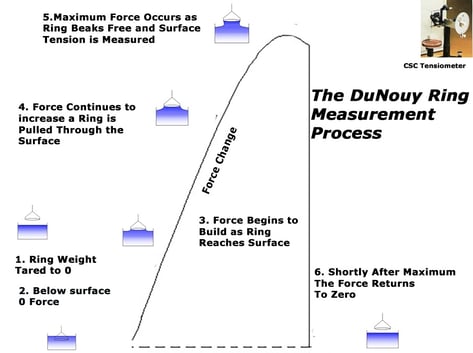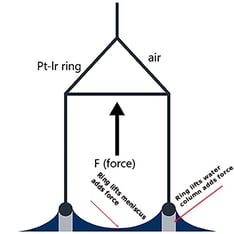An understandable definition of surface tension: “The attraction force between molecules at the surface of a liquid. The force that keeps if from flying off into space”.
The number (more than one-half dozen) of different test methods suggests the importance and complexity of surface tension measurements.
The duNouy Ring Surface Tension Measurement
The duNouy ring method is one of the more commonly used techniques. It is easy to do and there is a wide selection of duNouy ring instruments known as duNouy Tensiometers.
This method uses a platinum ring attached to the measuring device. To start the test, the ring is immersed just below the liquid surface. At this point the ring is free of any surface interference.
The next step is to slowly draw the ring out of the liquid. As the ring is pulled through the surface, the force holding the surface molecules together acts against the ring. This force is measured by the instrument until there is enough to pop the ring out of the liquid. This final force is presented as dynes per cm, or the surface tension of the liquid.
This illustration depicts the forces at different stages of the test.
The duNouy ring tensiometer reading, known as apparent surface tension, is used extensively for quality control, environmental assessment, product development and other reference markers.
What is Actual duNouy Surface Tension
Several factors, other than surface forces, act on the ring during a duNouy test. In some applications corrections need to be made for these anomalies. The result is actual surface tension.
The calculation of this correction accounts for several conditions.
The first - and perhaps easiest to understand - is that as the ring gets to the surface, just before breaking free, a circular column of the liquid is attached and held by the ring above the surface. The weight of the liquid column is part of the force measured but is not a surface tension force.
In addition, a portion of the liquid, which is directly under the ring, is pulled above the surface and is not due to surface tension forces – but rather capillary forces.
There are four more factors that add complexity to the development of actual surface tension: 1) the complex shape of the meniscus during the detachment of the ring, 2) the density of the liquid, 3) the circumference of the ring, and 4) the size of the wire.
To illustrate how mechanical type items affect the correction needed, here are four relationships:
1. As surface tension goes up, the correction % increases2. Increasing ring circumference causes higher correction %
3. Increasing liquid density results in higher correction %
4. Larger wire diameter moves correction % up
There are two principal correction formulas. One was developed by Huh and Mason and the other by Zuidema and Waters.
What to Use - Apparent or Actual Surface Tension
For years, more than I will admit to, I have proceeded in total darkness about apparent and actual surface tension. When asked about correction factors and correction charts, I just assumed that some users needed a correction for exotic purposes.
The vast majority of our tensiometer users never mentioned a need to make corrections to the instrument readings. All that most people were concerned about was calibration and repeatability.
Most of our customers apply the results duNouy ring tensiometer tests as shown on the dial, assured that this is the surface tension. They use these results in their formulation or quality control checks.
Impact of Digital Tensiometers
With the advent of digital tensiometers, and the ease of computation inherent electronics, the calculation of the duNouy correction factor is essentially automatic. A new standard may be developing: the use of duNouy ring tensiometer test results as actual surface tension.
The fun begins when a lab that has been using mechanical tensiometers and apparent surface tension obtains a new digital tensiometer. The new instrument shows lower results - 4%, 5%, maybe 6% lower.
A new food fight starts.
Which is correct, the old reliable or the newfangled digital?
What Will Your Lab Do?
An interesting real life dilemma: during the transition, what reading is to be used? The apparent surface tension on which the organizations standards are based, or the actual surface tension from the new instrumentation?
Convert every thing to the new real standard or convert backwards to the historical way of recording results?
It’s easy to say the conversion to real or correct should be done now. However, in the real world, the disruption that can be caused by this may not be worth it.
Now that you’ve been exposed to the reasons for and the meaning of apparent surface tension and actual surface tension, what will your organization do when you get your first digital tensiometer - the tensiometer that directly produces actual surface tension for duNouy ring tests?
I’m constantly in a battle to eliminate confusion about what I naively think should be simple concepts in the measuring business. Because of that, I think the gods purposely deluge me with simple things that need complicated answers - like Apparent vs Actual Surface Tension.
If you find this exposé useful, please share it with associates who work with surface tension.
Art
P.S. Did you know that you can subscribe to these exposés, rants, raves and ramblings? All you have to do is enter your email address into the box just to the right of the title.
P.P.S. Take a Look at the CSC Digital Tensiometer - check it out-- It reads in actual surface tension.

